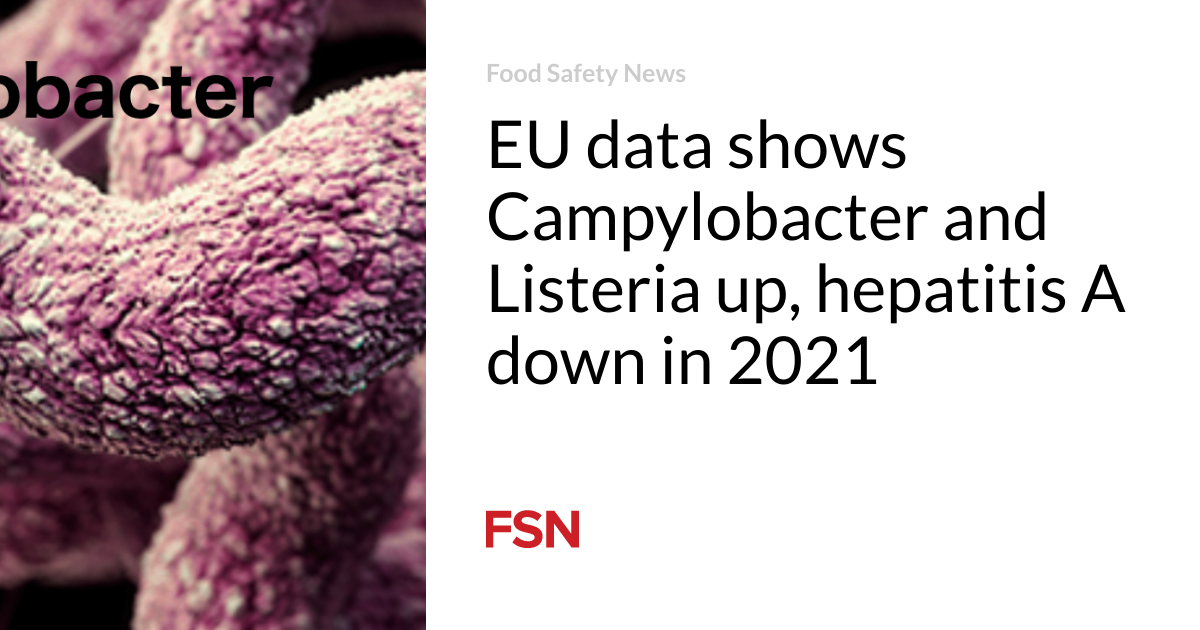Statistics on six diseases causing the most food and waterborne infections in Europe have been published by the European Centre for Disease Prevention and Control (ECDC).
The most recent data shows hepatitis A cases in 2021 were at their lowest since EU-level surveillance began in 2007, while five other diseases rose toward pre-pandemic levels.
Annual reports for Campylobacter and Listeria were not published in 2018, 2019 and 2020. The 2020 report for Salmonella was only made available in November 2022 and no report was published in 2018 and 2019. Details on hepatitis A, Campylobacter and Listeria are below. Salmonella, E. coli and Yersinia will be covered in another article.
Thirty countries recorded 3,864 Hepatitis A infections in 2021. In 2020, 4,400 cases were reported and, including the United Kingdom, 11,370 in 2019.
A reduction in cases was reported in Bulgaria, Denmark, and Estonia but infections in Hungary, Ireland, the Netherlands and Sweden went up. Romania had the most cases with 873, all of which were hospitalized, followed by 723 in Bulgaria and 582 in Germany.
Children aged between 5 and 14 accounted for a large proportion of cases. Compared to adults, they are more likely to develop mild disease. Adults older than 44 made up almost one-third of cases in Europe. Older adults are at increased risk of severe disease, hospitalization and death.
Five multi-country and one national cluster of hepatitis A virus infections were reported. Three multi-country epidemics were linked to the consumption of fresh or frozen berries.
Campylobacter cases
In 2021, 30 countries reported almost 130,000 confirmed cases of campylobacteriosis, with data including Liechtenstein for the first time since 2008. In 2020, 123,000 cases were reported and in 2019, the figure was almost 225,000 but this included infections in the UK.
Czech Republic and Slovakia had the top notification rates while the lowest were in Bulgaria, Cyprus, Greece, Poland, and Romania. Germany had the most infections with almost 48,000.
The number of deaths attributed to campylobacteriosis was 26 and of 47,000 cases with available data, 24 percent were hospitalized. Of more than 3,100 travel-associated cases with a known country of infection, 2,063 were linked to travel within the EU. The notification rate was highest in children younger than 5 and in males in all age groups.
A total of 249 foodborne outbreaks caused by Campylobacter involved 1,051 cases, 134 hospitalizations, and six deaths. Of 20 outbreaks with strong evidence, seven were caused by broiler meat or broiler products and three by bovine meat or meat products.
In 2021, 18.4 percent of more than 8,000 official control samples monitoring process hygiene at slaughterhouses exceeded the 1,000 Colony Forming Units per gram (CFU/g) limit.
Listeria levels
A total of 2,268 cases of listeriosis were reported in 2021 compared to 1,928 in 2020 and 2,652 in 2019.
Germany, France, and Italy had the most cases with 560, 435 and 241, respectively in 2021. The top incidence rates were in Iceland, Finland, and Denmark.
The most affected age group was those over 64 years old. Ninety-four cases of pregnancy-associated listeriosis were reported. Of these, 10 resulted in miscarriage or death of the newborn.
Microbiological clusters detected in the data show that although multi-country events tend to be small and affect only a few countries, they also often persist for several years, even decades.
Listeria monocytogenes was behind eight strong-evidence and 12 weak-evidence outbreaks that affected 94 people, with 38 hospitalized and nine deaths. Four strong-evidence outbreaks were caused by fish products with two each in the Netherlands and Sweden, three by meat products, reported by Austria, Finland, and Sweden, and one by broiler meat in Germany.
“The persistently stable trend seen at the EU/EEA-level and the severity of listeriosis are worrying and call for more attention to be given to the prevention and control of the disease and outbreaks,” said ECDC.
(To sign up for a free subscription to Food Safety News, click here.)

